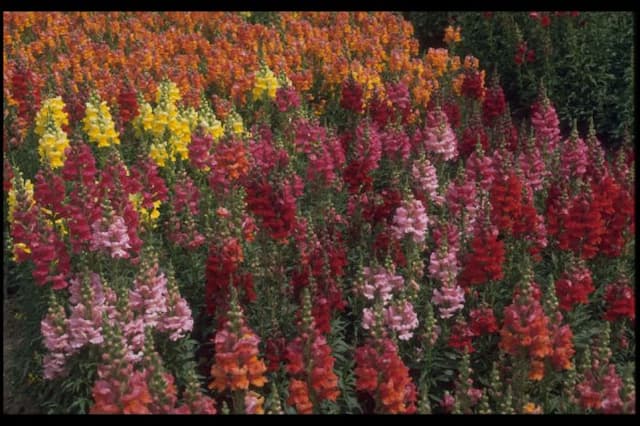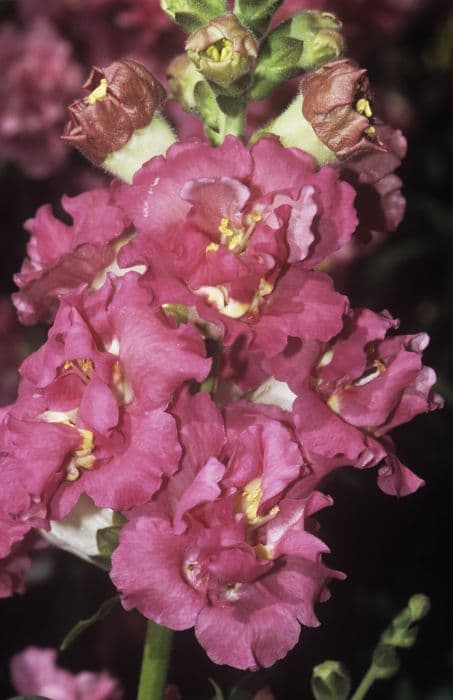Beardtongue Penstemon 'Midnight'

ABOUT
Penstemon 'Midnight', commonly known as beardtongue, is a striking perennial plant known for its decorative and colorful appearance. This variety is distinguished by its deep purple to almost black tubular flowers, which are a favorite among garden enthusiasts for their rich hue. The flowers have a bell-like shape that hangs in clusters from the top portions of erect, strong stems. At the base of these stems are lance-shaped leaves that provide an attractive green contrast to the dark blossoms. The foliage itself is often dense and can vary from bright to deep green, sometimes with a fine layer of fuzz. Beardtongue flowers feature a prominent lower lip that is meant to aid in pollination, providing a landing pad for various pollinators like bees and hummingbirds. Each individual flower is composed of five lobes, with the interior often showcasing a contrasting color, such as white or pale violet, that can create a striking pattern against the dark petals. The overall form of the plant is upright and clump-forming, presenting a bushy appearance that becomes more pronounced as the plant matures. Its blooming period typically occurs in late spring to early summer, offering a display of color when many other plants have not yet reached their peak. The attractiveness of Penstemon 'Midnight' is heightened by its lush flower spikes that create a dramatic visual effect in garden beds and borders.
About this plant
 Names
NamesFamily
Plantaginaceae
Synonyms
Beardtongue, Penstemon
Common names
Penstemon 'Midnight'
 Toxicity
ToxicityTo humans
Beardtongue is generally considered non-toxic to humans. Ingestion of any part of the plant typically does not lead to serious poisoning. However, as with many plants, individual sensitivities can vary, and consuming plant parts may potentially cause mild gastrointestinal discomfort for some individuals.
To pets
Beardtongue is also generally considered non-toxic to pets. It is not known to cause serious illness or toxicity if pets ingest parts of this plant. Nevertheless, individual animals may experience different sensitivities, and ingestion may result in mild gastrointestinal upset in pets with sensitive stomachs.
 Characteristics
CharacteristicsLife cycle
Perennials
Foliage type
Deciduous
Color of leaves
Green
Flower color
Blue
Height
2-3 feet (0.6-0.9 meters)
Spread
1-2 feet (0.3-0.6 meters)
Plant type
Herb
Hardiness zones
4-9
Native area
North America
Benefits
 General Benefits
General Benefits- Attracts Pollinators: Penstemon 'Midnight', also known simply as Beardtongue, is highly attractive to bees, butterflies, and hummingbirds, contributing to the pollination of your garden and the broader ecosystem.
- Drought Tolerant: Once established, Beardtongue is known for its ability to withstand periods of low water, making it ideal for xeriscape gardens and water-wise landscaping.
- Low Maintenance: This plant typically requires minimal care, reducing the need for frequent watering, pruning, or fertilization, thus saving time and resources.
- Long Blooming: Beardtongue has a long flowering season, providing vibrant colors and visual interest to the garden for an extended period of time.
- Deer Resistant: The traits and foliage of Beardtongue are generally not preferred by deer, making it a good choice for gardens in areas where deer browsing is a problem.
- Versatile Landscaping: Beardtongue can be used in a variety of landscape settings, including borders, rock gardens, and wildflower meadows, due to its adaptable nature.
- Aesthetic Appeal: The striking deep purple-to-navy flowers of Penstemon 'Midnight' add a dramatic touch to the landscape, enhancing its overall beauty.
 Medical Properties
Medical PropertiesThis plant is not used for medical purposes.
 Air-purifying Qualities
Air-purifying QualitiesThis plant is not specifically known for air purifying qualities.
 Other Uses
Other Uses- Educational Tools: Penstemon can be used in educational settings such as schools or botanical gardens to teach about plant growth, pollination, and the importance of preserving native species.
- Artistic Inspiration: The vivid colors and unique shape of Penstemon flowers can inspire artists and photographers, leading to their use in various art projects and photographic works.
- Dye Production: The flowers of Penstemon might be used to create natural dyes for coloring textiles, though specific methods and results can vary based on the species used.
- Culinary Garnish: While not widely known for culinary uses, the flowers of Penstemon can be used as an edible decoration on salads and desserts for an unusual twist.
- Erosion Control: Planting Penstemon in areas prone to soil erosion can help stabilize the soil due to their deep-rooting nature.
- Habitat Creation: Penstemon can create natural habitats and provide food for specific species of bees and hummingbirds that rely on native flora for sustenance.
- Crafting and Flower Arrangements: The stems and flowers of Penstemon can be used in crafting and floral designs, making beautiful and long-lasting arrangements.
- Insect Deterrent: Certain Penstemon varieties might have properties that deter specific pests, making them a natural choice for companion planting in gardens.
- Thematic Landscaping: Penstemons can be used to create thematic garden displays, such as those focusing on nighttime or dark themes due to their 'Midnight' moniker.
- Seasonal Celebrations: Penstemon can be included in seasonal garden displays, especially in celebrations that correspond with their blooming period for a natural decorative element.
Interesting Facts
 Feng Shui
Feng ShuiThe Beardtongue is not used in Feng Shui practice.
 Zodiac Sign Compitability
Zodiac Sign CompitabilityThe Beardtongue is not used in astrology practice.
 Plant Symbolism
Plant Symbolism- Endurance: Penstemon varieties, including 'Midnight', often symbolize endurance due to their hardy nature and ability to thrive in challenging environments.
- Diversity: With the wide range of colors and species, Penstemon can represent the beauty of diversity and variation in life.
- Health and Vitality: 'Midnight' Penstemon, with its rich and vibrant hues, is considered to be a symbol of good health and a strong constitution.
- Boldness: The striking appearance of the 'Midnight' Penstemon can signify boldness and the courage to stand out from the crowd.
- Balance: As Penstemon grows well in various environments and balances its ecological niche, it can symbolize the importance of balance in our lives.
 Water
WaterBeardtongue, commonly referred to for Penstemon 'Midnight', prefers consistent moisture but is also tolerant of drought once established. During the first growing season, water the plant deeply once a week, providing about one to two gallons per plant to encourage deep root growth. Once established, water it every two weeks, depending on the weather, adjusting for rainfall to prevent waterlogging. In hot summer months, increase watering frequency as needed but allow soil to dry out slightly between watering.
 Light
LightBeardtongue thrives in full sun, receiving at least six hours of direct sunlight each day. It can tolerate partial shade, but flowering is most prolific in full sun exposure. The ideal spot is an area with unfiltered sunlight for the majority of the day, ensuring the plant has adequate light to bloom effectively.
 Temperature
TemperatureBeardtongue plants are hardy in a wide range of temperatures, tolerating a minimum temperature of about 20 degrees Fahrenheit. They can survive up to 85 degrees Fahrenheit but perform best in moderate conditions between 50 and 70 degrees Fahrenheit. Plant in an area that doesn’t experience extreme temperature fluctuations for optimal growth.
 Pruning
PruningPrune Beardtongue in late winter or early spring before new growth begins. Trimming back dead or woody stems encourages fresh growth and improves the plant's shape. Annually remove spent flower stalks to promote additional blooming and prevent self-seeding if not desired.
 Cleaning
CleaningAs needed
 Soil
SoilBeardtongue 'Midnight' prefers well-draining soil with a mixture of loam, sand, and organic matter. The best soil mix for Penstemon 'Midnight' would include two parts loam, one part coarse sand or perlite for drainage, and one part compost or well-aged manure for fertility. The pH should be slightly acidic to neutral, ranging from 6.0 to 7.0 for optimal growth.
 Repotting
RepottingBeardtongue 'Midnight' should be repotted every 2 to 3 years or when it outgrows its current container. Use a fresh soil mix when repotting, and choose a container that is one size larger than the current one to allow for growth.
 Humidity & Misting
Humidity & MistingBeardtongue 'Midnight' can tolerate a wide range of humidity levels but prefers moderate levels. Aim to maintain ambient humidity around the plant, as excessive humidity can lead to pest and disease issues.
 Suitable locations
Suitable locationsIndoor
Provide bright light, well-draining soil, and moderate watering.
Outdoor
Full sun to partial shade, well-draining soil, and weekly watering.
Hardiness zone
4-9 USDA
 Life cycle
Life cycleThe life cycle of the Penstemon 'Midnight', commonly known as Beardtongue, begins with seed germination, which occurs in late winter to early spring under favorable conditions of warmth and moisture. Seedlings emerge and establish a root system while developing true leaves, entering the vegetative growth stage where they focus on accumulating resources and growing foliage during the spring and summer. As they mature, Beardtongues enter the flowering stage, typically in late spring to early summer, producing tall spikes of tubular flowers that are pollinated by insects, particularly bees. After pollination, the flowers develop into fruit capsules containing numerous small seeds, which ripen by late summer to fall. Once the seeds are dispersed by wind or other mechanisms, the plant enters a period of dormancy, particularly in regions with cold winters, where it survives with reduced activity until the next growing season. Throughout its life, the perennial Beardtongue can regenerate and spread through clumping and occasionally by self-seeding, with individual plants often living several years.
 Propogation
PropogationPropogation time
Spring-Early Summer
The most popular method of propagating Penstemon 'Midnight' is by stem cuttings, ideally done in late spring or early summer when the plant is in active growth. To propagate, select healthy, non-flowering stems and cut a 4 to 6-inch portion just below a node using a clean, sharp knife or scissors. Remove the leaves from the lower half of the cutting, and dip the cut end into a rooting hormone powder to encourage root development. Plant the cutting in a pot filled with a well-draining soil mix, ensuring at least one node is buried where roots can emerge. Water the cutting well and place it in a warm area with indirect sunlight. Covering the pot with a plastic bag can create a greenhouse effect, maintaining humidity around the cutting. Roots typically develop in a few weeks, after which the new Penstemon 'Midnight' plants can be transplanted into their permanent location.





![Snapdragon [Pretty in Pink]](/_next/image?url=https%3A%2F%2Fplants-admin.emdemapps.com%2Fimages%2Fplants%2F%2Fimages%2F604b5cb3b5385.png&w=640&q=75)



